
Blinkit Case Study
Introduction:
In today’s digital age, our mobile phones have become indispensable tools, serving a multitude of purposes from shopping to learning and relaxation. With just a swipe of our screens, we can access a vast array of goods and services, making the world more accessible than ever before. Gone are the days when we had to venture out to buy groceries and daily essentials; now, all we need is our mobile phone and an internet connection.
When it comes to ordering groceries, one of the first names that comes to mind is Grofers/Blinkit, a prominent player in the e-commerce space. Recently, this online grocery delivery unicorn underwent a rebranding to Blinkit, aligning with its goal of providing swift grocery deliveries. Blinkit was acquired by Zomato, a leading food tech unicorn, in a significant deal worth $569 million (Rs 4,447 crore) on June 24, 2022.
To delve deeper into Blinkit’s journey, including its founders, business model, revenue streams, funding, competition, and challenges, read on in this article for a comprehensive overview.
Grofers – Company Highlights
STARTUP NAME | GROFERS |
Headquarters | Gurugram, India |
Sector | Online Shopping/Ecommerce/Grocery Delivery |
Founders | Saurabh Kumar, Albinder Dhindsa |
Founded | December 2013 |
Area Served | India |
Parent Organization | Grofers International Pvt Ltd |
Website | blinkit.in / grofers.com |
Grofers – About
Established in 2013, Grofers, now rebranded as Blinkit, is an Indian online grocery delivery service headquartered in Gurugram. This e-commerce platform offers a diverse range of everyday essentials such as groceries, bakery items, and baby care products to its customers.
Through the Blinkit mobile application, users can conveniently browse and purchase their desired products, scheduling deliveries at their preferred times. Grofers’ dedicated employees then ensure the timely delivery of these items to customers’ doorsteps. Presently, Blinkit operates across 23 cities in India, serving a growing customer base.
How do Grofers deliver their orders in 10 minutes?
In June 2021, Grofers made headlines by announcing a major upgrade to its delivery service, aiming to fulfill orders within just 10 minutes of being placed online. The popular online grocery platform also pledged to achieve this swift delivery goal in cities where it operates within 45 days. However, this ambitious promise drew significant criticism from people across the country, with many accusing Grofers of potentially overworking its employees to meet such tight delivery deadlines.
In response to the backlash, Albinder Dhindsa, one of the founders of Grofers, addressed the concerns raised by stating:
“It breaks my heart that instead of celebrating innovation coming from India, some of us stay cynical of people who are trying to break the status quo.”
In explaining how Grofers achieves its 10-minute delivery target, Dhindsa highlighted that the company strategically partners with stores located within a 2-kilometre radius of customers, a significant advantage. With over 60 partner stores in Delhi and over 30 in Gurgaon, along with a substantial presence in other cities like Mumbai, Kolkata, and Bengaluru, Grofers ensures proximity to its customers.
Dhindsa emphasised on Twitter that the stores are strategically placed, allowing for quick deliveries, with 90% of orders easily delivered within 15 minutes, even at a moderate driving speed of 10 km/hr. Additionally, Grofers utilises advanced technologies for efficient in-store planning and management, enabling orders to be packed within just 3 minutes of receiving them. Furthermore, Dhindsa clarified that Grofers riders are not pressured to deliver orders rapidly; they work at their own pace.
Highlighting safety, Dhindsa mentioned that, since implementing the 10-minute delivery system, Grofers has not experienced any reported rider accidents in the past two months.
Transitioning from Grofers to Blinkit, the company is now even more committed to rapid grocery delivery. Albinder Dhindsa, Co-founder and CEO of Blinkit (formerly Grofers), emphasised the importance of quick commerce. According to Dhindsa, the 10-minute delivery pledge by Blinkit is not only feasible but necessary in today’s fast-paced lifestyle. He believes that swift delivery services like Blinkit’s can save valuable time for customers, allowing them to focus on more significant tasks.
Grofers – Startup Story | How did it started?
Following his graduation, Albinder ventured into the transportation sector as an analyst at URS Company in the USA. During this stint, he crossed paths with Saurabh Kumar, maintaining a casual friendship without harbouring any entrepreneurial aspirations.
However, both Albinder and Saurabh identified a significant gap in the delivery industry, spurred by the burgeoning startup ecosystem. Recognizing the untapped potential in the unorganised hyperlocal delivery space, they envisioned a solution to streamline transactions between merchants and consumers.
This realisation marked the inception of their entrepreneurial journey. Their vision was to create a comprehensive platform addressing local delivery needs, offering on-demand pickup and drop services. Their platform aimed to optimise logistics by facilitating deliveries from neighbourhood stores such as grocery outlets, pharmacies, and eateries. In the initial phases, they facilitated grocery deliveries from nearby stores and supermarkets, laying the groundwork for their startup.
About the founders
Blinked, previously Grofers, was established by Albinder Dhindsa and Saurabh Kumar in 2013. Their partnership originated during their tenure at Cambridge Systematics in the late 2000s, where they recognized an opportunity in the grocery delivery sector. Their objective was to address the inherent challenges associated with the industry’s fragmented structure, focusing on both customer and merchant aspects. The startup commenced its operations in Delhi NCR before gradually expanding to other regions across India.
Acquisition of Blinkit by Zomato
After extensive discussions, negotiations, and financial arrangements, Zomato completed the acquisition of Blinkit on June 24, 2022. The acquisition, valued at $568 million, involved an all-stock transaction. Zomato’s board approved the acquisition, agreeing to acquire up to 33,018 equity shares of Blink Commerce Pvt Ltd from its shareholders. This acquisition, totaling Rs 4,447.48 crore ($569 million), was disclosed by Zomato on the BSE. Notably, Blinkit’s previous valuation of $1 billion underwent a reduction of 43%. Additionally, as part of the deal, Zomato Hyperpure, the company’s B2B division, acquired BlinkIt’s B2B business Hands on Trade Private Limited (HOTPL) warehousing and ancillary services business for Rs 60.7 crore, as revealed in the accessed filings. Zomato’s acquisition of Blinkit aligns with its strategic goal of focusing on quick commerce, a rapidly growing sector in India and globally. Quick commerce involves the swift delivery of essential items like groceries, meeting the increasing demand for convenience among customers. It’s important to note that Blinkit’s parent organization is not Zomato, but Zomato saw value in integrating Blinkit’s operations to enhance its presence in the quick commerce space.
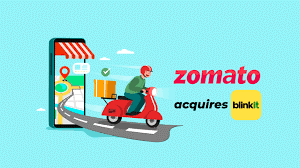
How Does it Work?
Blinkit, an online grocery delivery platform, guarantees to deliver a selection of nearly 7,000 products within a remarkable 10-minute timeframe. Operating across more than 30 cities nationwide, Blinkit strategically partners with stores located within a 2 km radius to facilitate swift deliveries. In Delhi alone, Blinkit boasts over 60 partner stores. Through enhanced in-store planning and technological advancements, Blinkit has significantly improved its operational efficiency, enabling orders to be packed within a mere 2.5 minutes of placement.
How Blinkit Makes Money?
During the delivery process from the warehouse to the customer’s doorstep, Blinkit manages multiple stages involving logistics, delivery partners, suppliers, vendors, and technology and merchant partners. Despite the complexity of these operations, this is where the revenue generation primarily occurs.
Blinkit meticulously monitors the quality of all groceries stocked in its warehouses, ensuring an efficient handling process. When a customer places an order via the Blinkit mobile app, it seamlessly connects with various brands and local stores. Blinkit earns a commission ranging from 8% to 15% on each transaction. Additionally, Blinkit is strategically investing in private brands, which have already begun to generate substantial revenue streams.
Grofers – Name, Tagline and Logo
Blinkit emerged as the fresh identity of Grofers following its rebranding endeavor on December 13, 2021. The adoption of the new name aligns with the company’s mission to provide ultra-fast grocery deliveries, symbolized by the concept of blinking—an instantaneous action.
Accompanied by the tagline “Lets Blink it” or #letsblinkit, the brand underscores its commitment to swift and efficient service.
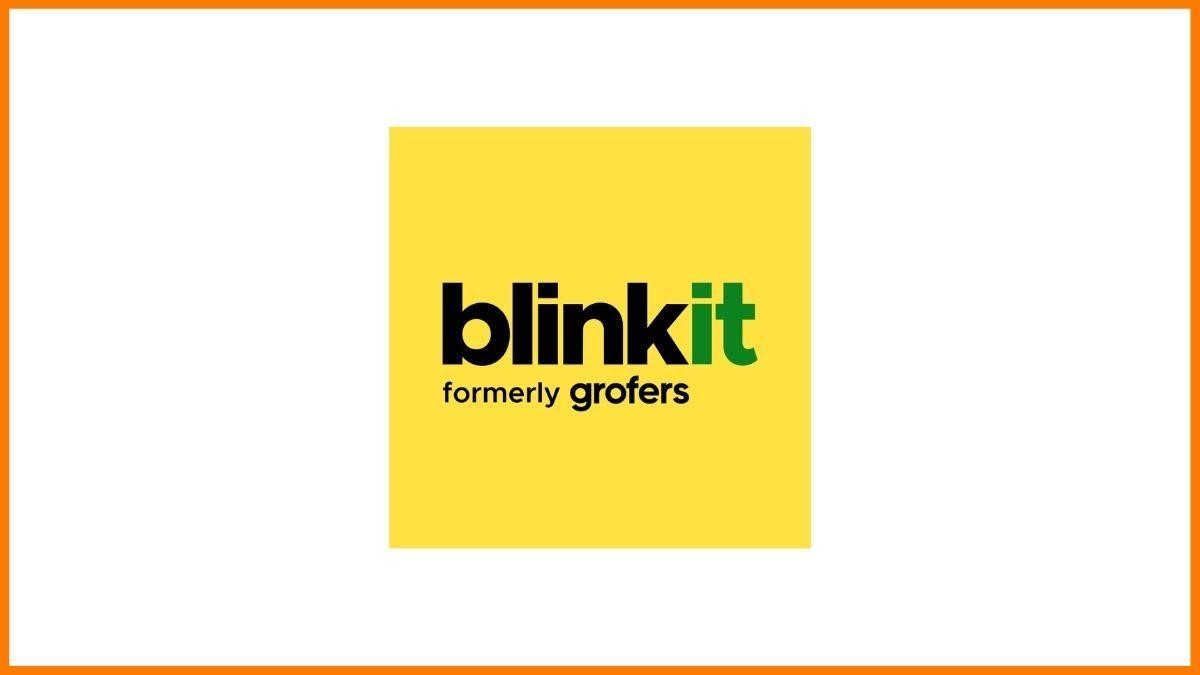
Before rebranding as Blinkit, the company was known as Grofers, a name formed by blending “Grocery” and “Gophers,” the latter referring to individuals responsible for errands. Under the tagline “We get it,” Grofers launched its online advertising campaign, emphasizing its understanding of customers’ needs and preferences.
Grofers – Mission and Vision
Blinkit, formerly known as Grofers, has adopted a new mission statement: “instant commerce indistinguishable from magic.” The company is committed to providing customers with swift grocery deliveries within 10 minutes. Blinkit aims to thrive in the quick commerce sector, prioritising seamless and rapid delivery services.
Grofers – Business Model
Grofers operates on a marketplace business model, often described as a hyperlocal on-demand logistics system. Its objective is to eliminate the need for consumers to physically visit local stores for purchasing consumer goods by providing an online alternative. Unlike traditional retailers, Grofers does not own any grocery stores or warehouses.
Instead, it collaborates with local grocery stores in various cities and dispatches its delivery personnel to collect ordered items from these establishments. Customers place orders through Grofers’ mobile application or website. This partnership arrangement benefits local grocery store owners by increasing their order volume, while Grofers earns revenue by charging a commission on each order.
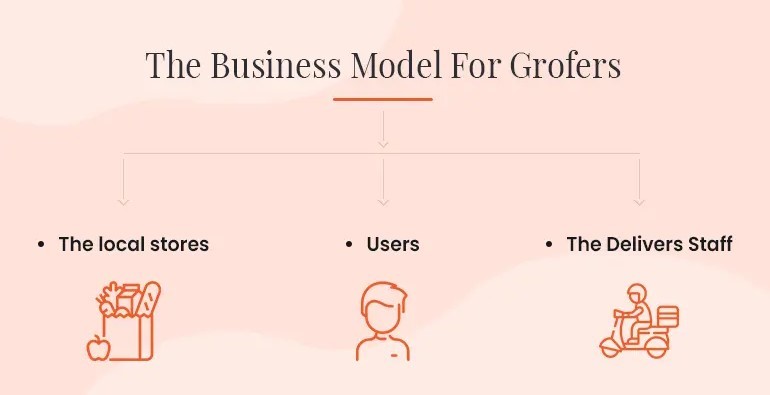
Here are some key insights into the inventory-based business model of Blinkit:
Key Partners
Grofers, now known as Blinkit, collaborates with a network of local merchants and brands, logistics partners, payment service providers, investors, and acquired entities.
Key Activities
Some of the key operations undertaken by Grofers include:
- Grocery delivery services
- Warehousing operations
- Supply chain management
- Platform and technology maintenance
- Shipping logistics
- Development of software and innovative products
- Customer service provision
Key Resources
Blinkit leverages various resources, including:
- State-of-the-art technology
- Intellectual property assets
- Sophisticated IT and communication infrastructure
- Efficient delivery channels
- A network of local merchants
- Funding obtained through investment rounds
Customer Segments
Grofers considers all residents of India, including local merchants, as its customers.
Advertising Channels
Grofers, now known as Blinkit, promotes its brand through blogs, social media platforms, and utilises word-of-mouth marketing extensively.
Blinkit Revenue
Blinkit makes money through various methods, including:
Revenue Streams:
- Commission on Orders: Blinkit earns revenue by charging a commission on each order made through its platform. The commission rate varies depending on the category of items purchased, with groceries typically having a lower commission rate than electronics.
- Delivery Fees: Blinkit imposes a delivery fee on every order placed via its platform, usually amounting to $2-$3. However, the company frequently offers discounts and promotions that may reduce or waive the delivery fee.
- Subscription Fees: Blinkit provides a subscription service called Blinkit Prime, which members can join for a fee. Blinkit Prime members enjoy perks such as free delivery on orders exceeding INR 4000, early access to new products, and discounts on specific items.
- Advertising: Blinkit generates revenue by selling advertising space on its platform. Advertisers can place ads on Blinkit’s website, app, and even its delivery vehicles.
- Partnerships: Blinkit collaborates with other businesses to offer discounts and promotions to its customers. For instance, the company has teamed up with Amazon Prime to provide free delivery on Amazon orders exceeding $50 to its customers.
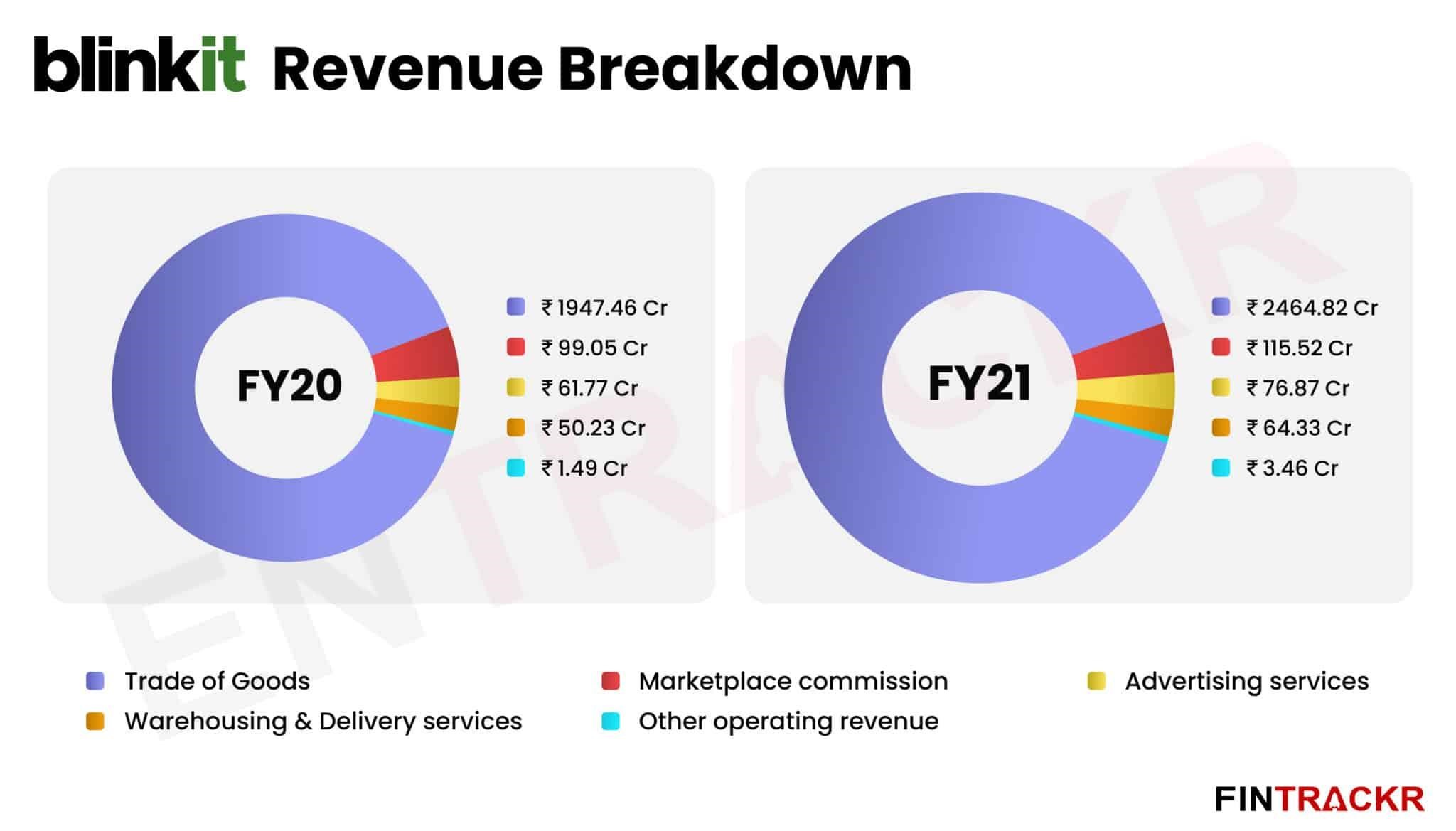
Financials
Blinkit’s operational revenue surged from Rs 236.1 crore in the fiscal year 2022 to Rs 724.2 crore in the fiscal year 2023. However, concerning the company’s profitability, there was a rise in losses from Rs 996.7 crore in FY22 to Rs 1,078.9 crore in FY23.
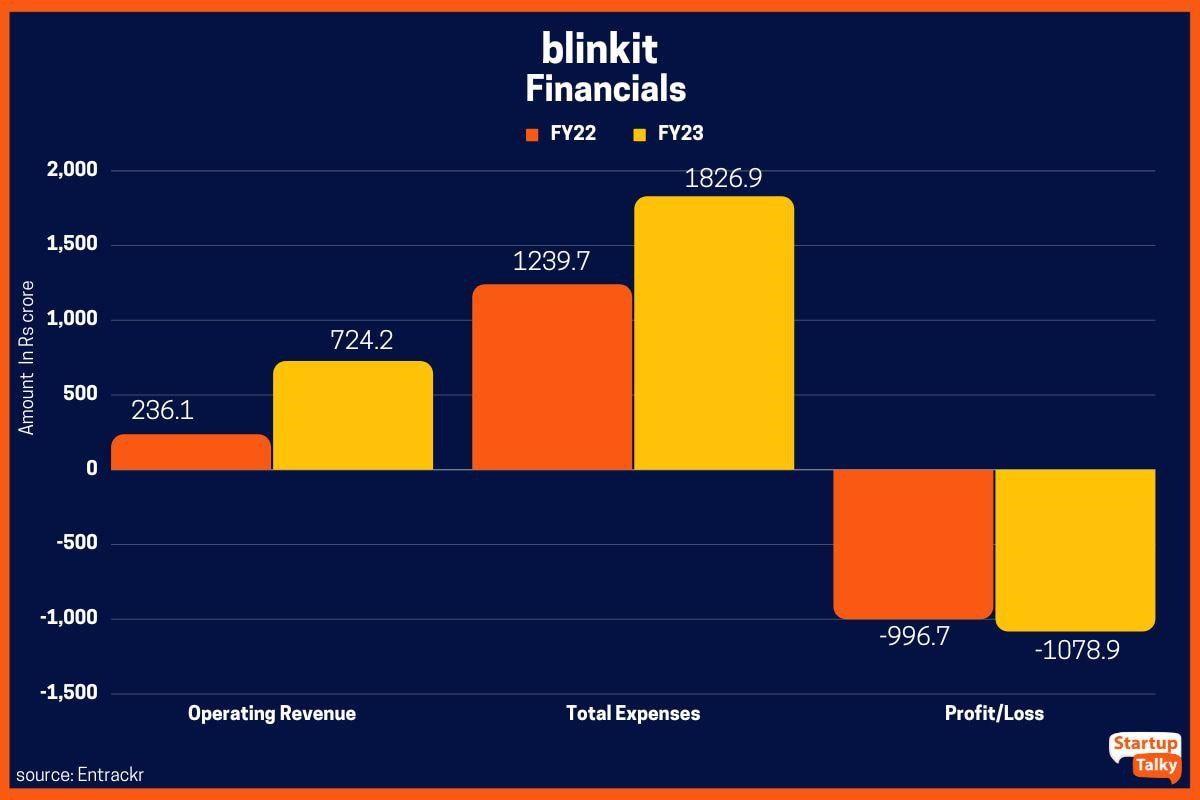
Blinkit Franchise
Blinkit presents an enticing opportunity for aspiring entrepreneurs seeking to kickstart or expand their ventures. As a Blinkit franchisee, you tap into the company’s established brand, cutting-edge technology, and efficient logistics infrastructure. Moreover, Blinkit extends comprehensive training and ongoing support to ensure your success.
To qualify for a Blinkit franchise, you must meet specific criteria:
– Possess a minimum net worth of ₹10 lakhs
– Accumulate at least 5 years of experience in either the retail or e-commerce sectors
– Commit an investment of ₹5 lakhs as the franchise fee
– Secure a suitable location for your franchise operation
If you’re interested in joining the Blinkit family, you can submit your application online or reach out to Blinkit’s franchise team directly.
Here are some advantages of owning a Blinkit franchise:
Brand Recognition:
Blinkit enjoys widespread recognition across India, offering franchisees immediate access to this established reputation.
Technology:
Employing cutting-edge technology, Blinkit ensures lightning-fast deliveries of groceries and essentials within 10 minutes. This technological prowess is also at the disposal of franchisees, granting them a competitive advantage.
Logistics Network:
Benefiting from a nationwide logistics network, Blinkit facilitates swift and efficient order deliveries. Franchisees can leverage this network to streamline their product distribution process.
Training and Support:
Blinkit prioritizes the success of its franchisees by providing comprehensive training on the company’s technology, logistics operations, and marketing strategies.
As Blinkit continues its rapid expansion, joining its franchise program presents a lucrative opportunity to enter the burgeoning quick commerce industry. For guidance on business strategy and other vital aspects, Rahul Malodia stands ready to assist you in ensuring a profitable venture.
Success Secrets of Grofers Business Model
Several factors have propelled Blinkit to its current success:
Emphasis on Speed:
Blinkit places a paramount focus on speed, aiming to fulfill orders within a remarkable 10-minute window. This commitment has driven substantial investments in cutting-edge technology and streamlined logistics.
Diverse Product Range:
Blinkit boasts an extensive array of offerings, spanning groceries, snacks, beverages, and personal care items. This comprehensive selection caters to customers’ diverse needs, establishing Blinkit as a convenient one-stop destination.
Flexible Ordering and Delivery Channels:
Blinkit provides customers with multiple avenues for placing orders and receiving deliveries, ranging from online and in-app ordering to voice commands. This versatility ensures accessibility and convenience for patrons seeking prompt access to desired products.
Competitive Pricing:
By maintaining competitive price points across its product range, Blinkit positions itself as an affordable alternative to traditional grocery outlets, appealing to cost-conscious consumers.
Strategic Marketing Initiatives:
Blinkit has executed robust marketing campaigns to enhance brand visibility and promote its services effectively. These efforts have significantly contributed to the company’s ability to attract a sizable customer base.
With a sound business model and effective management, Blinkit is poised for continued growth in the foreseeable future.
Grofers – Competitors
As the pace of growth accelerates across various e-commerce platforms, the online grocery market in India has expanded significantly. Major brands and supermarkets are increasingly transitioning to online sales, prompting existing players to focus on brand retention and customer loyalty.
Grofers, in particular, faces stiff competition from several prominent rivals, including:
– BigBasket
– Swiggy
– Zepto
– Pepper Tap
– Zopnow
– Dunzo, among others.
Despite enjoying favor among investors since its inception, Grofers contends with intense competition within the e-commerce landscape. Moreover, the entry of industry behemoth Amazon into the online grocery sector poses a significant threat to established brands like Grofers.
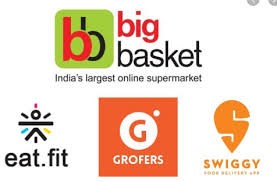
Grofers – Future Plans
Blinkit once proudly held approximately 13% of the overall market share, positioning itself as the third-largest player among online grocery delivery platforms, trailing behind Bigbasket and Amazon. Bigbasket currently dominates the market with roughly 37% of the total market share, followed by Amazon with a 15% share.
Operating under the umbrella of Zomato, Blinkit aspires to emerge as the flagship online delivery service within the Zomato ecosystem.
Conclusion
Blinkit, formerly Grofers, is a rapid online grocery delivery platform that operates across more than 30 cities throughout India. They have established partnerships within a close proximity of approximately 2 kilometres in each city, boasting over 60 partner stores in Delhi alone. The company pledges to deliver a diverse array of products within a remarkable 10-minute timeframe.
Initially, Blinkit aimed to bridge the gap between customers and local vendors. However, this approach encountered several challenges. Consequently, the company transitioned to an inventory-based model, which proved to be highly successful. This new model enables Blinkit to maintain strict quality control over the products delivered to customers, ensuring a superior customer experience.







